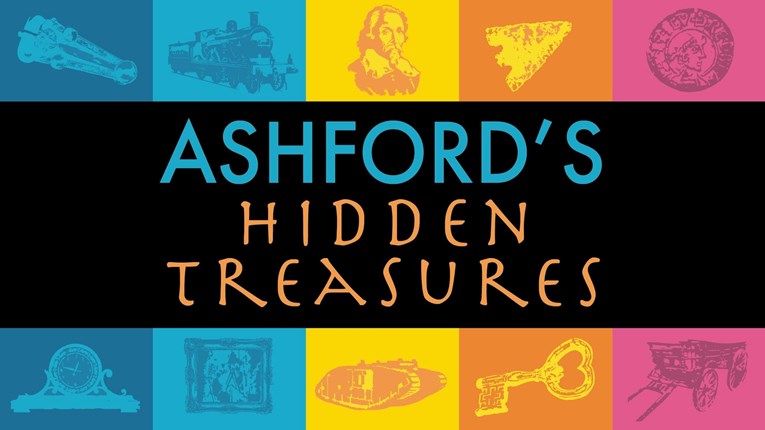Ashford's Hidden Treasures

Ashford’s Hidden Treasures, produced by Funder Films CIC and funded by the National Lottery Heritage Fund, is a series of short videos to celebrate some of the amazing objects found in museums and archives in the borough of Ashford.
The vast majority of artefacts are in museums and public collections and therefore publicly accessible. However, some artefacts are in private collections.
The first object in Ashford’s Hidden Treasures is a Bout Coupe Handaxe dating from 60,000-40,000 BC and is part of a private collection. Andrew Richardson of Canterbury Archaeology Trust tells us about the hand axes found in Kent and what they were used for.
Episode two of Ashford’s Hidden Treasures features The Ashford Little, an ambulance from 1899 currently on display at Ashford Borough Museum. Ashford Museum Curator, Ian Sharp, talks about the importance of the Ashford Little as well as the life of its designer, Sir John Furley.
Episode three features the Tenterden Tapestry created in 1974 and currently on display in Tenterden and District Museum. Tenterden Museum Curator, Robin Wilkins, talks about the creation of the Tenterden Tapestry and the design of this unique object.
Episode four of Ashford’s Hidden Treasures features a Kentish Pole Wagon currently on display at Brook Agricultural Museum. Graham Bradley, Trustee of Brook Agricultural Museum talks about the significance of the Pole Wagon.
Episode five features Ellen Terry’s Beetle Wing Dress. The dress is usually on display at Smallhythe Place but it will be on display at the Museum of Fine Art in Boston in 2022 and the Tate Modern in London in 2024. In this episode, Nicci Obholzer, Assistant Collections Officer at National Trust Smallhythe Place, talks about the dress and the leading actress who wore it – Ellen Terry.
Episode six of Ashford’s Hidden Treasures features a Class 71 locomotive currently on display at the Locomotion Museum in Durham. Anthony Coulls, Senior Curator of Rail Transport and Technology at the National Railway Museum, talks to us about the significance of the locomotive and its links to Ashford.
Episode seven features Corporal Samuel Brunger’s World War One letter that is part of the Great Chart Remembers collection. Ian Wolverson, Chair of Great Chart Remembers, talks about the letter, its author, and the significance of wartime letters. The 22 albums of letters from the World War One servicemen of Great Chart are held in Kent Archives at the Kent History & Library Centre, Maidstone.
Episode eight of Ashford Hidden Treasures visits Biddenden for a biscuit that should be edible but is way past its sell-by date. The biscuit is in the care of Biddenden History Society. Archivist and Treasurer of Biddenden Local History Society, Tony Churton, tells us about the design of the biscuit and how these biscuits play an important role in the history of Biddenden village.
Episode nine looks at The Crundale Buckle dating from the 7th century, currently in the care of the British Museum. Andrew Richardson, Canterbury Archaeology Trust, tells us where the artefact was found and the type of person that would have worn such a piece.
Episode 10 features a late 18th century recruiting poster for the New Romney Fencibles. The poster is currently in the care of Ashford Family History Society. Janet Welch, Secretary of the Ashford Branch of the Kent Family History Society tells us about the New Romney Fencibles.
Episode 11 of Ashford’s Hidden Treasures features Van 132 (The Cavell Van) Railway Wagon that is currently in the collection of the Kent and East Sussex Railway, Tenterden. Brian Jones, Curator of The Colonel Stephens Railway Museum, Tenterden, talks about the wagon’s history and how it became a national icon.
Episode 12 features a 19th century painting of the Wye Racecourse. Maureen de Saxe, Archivist for Wye Historical Society, talks about the painting and the history of horse racing at Wye.
Episode 13 of Ashford’s Hidden Treasures features a visit to Small Hythe – what was the third largest shipbuilding port in England during the medieval period, and scene of Channel 4’s Time Team archaeology dig in 1998. Robin Wilks, Curator of Tenterden and District Museum, showcases a fragment from a medieval ship dating between 12th-15th century and currently in the care of Tenterden Museum.
Episode 14 features a D-class 440 Locomotive (1901) currently on display at the National Railway Museum in York. Anthony Coulls, Senior Curator, Rail Transport and Technology at the National Railway Museum talks about the train’s use.
Episode 15 of the Ashford’s Hidden Treasures project features The Crundale Hoard from the Late Bronze Age c.850BC - 750BC. The Hoard is currently part of Canterbury Museum’s collection. Andrew Richardson of Canterbury Archaeological Trust talks about where the hoard was found and the significance of the discovery.
Episode 16 features pictures of the Kindertransport children in 1939. Charles Boxer, Curator at Woodchurch Village Life Museum, tells the story of Great Engeham Farm acting as a transit camp for Jewish Refugee Children pre-Second World War.
Episode 17 of Ashford’s Hidden Treasures features The Vinegar Bible printed in 1717 by John Baskett. This particular Bible belongs to Boughton Aluph but is now in the care of Canterbury Cathedral Library and Archives who make it available for research. Fawn Todd, Cathedral Librarian at Canterbury Cathedral Archives and Library, tells us how this Bible got its name and why it is so unique.
Episode 18 features a Creda Carefree Electric Cooker from the late 1950s that is currently on display at Tenterden and District Museum. Robin Wilkins, Museum Curator, tells us why this piece of engineering was so special in its day.
Episode 19 of Ashford’s Hidden Treasures features early 17th century statues of ancient Britons currently at Wye Heritage Centre. Francis Huntington, Trustee of Wye Heritage, tells us about the statues and their history.
Episode 20 features a 17th century Bellarmine Jar currently in the care of Pluckley Heritage Centre. Kaye Sowden from Pluckley Heritage Centre talks about how the jar and similar objects were used as protection against witches.
Episode 21 of Ashford’s Hidden Treasures features Jared Hill’s map of Woodchurch from 1729. The map is part of the collection at Woodchurch Village Life Museum. Jon Chaplin and Josie Mackie of Woodchurch Ancestry Group talk about the history and uniqueness of the map.
Episode 22 features a heavy metal chain used to moor airships at Godmersham Park during the First World War. Jane Moczulski, Administrator at Godmersham Park Heritage Centre, talks about what the airships were used for and where they were moored.
Episode 23 of Ashford’s Hidden Treasures features a model of the Eurostar from the early 1990s. The model is currently on display at the Ashford International Model Railway Education Centre (AIMREC) in Bethersden. Fred Garner, Director of AIMREC, talks about what makes this model so special.
Episode 24 features a painting ‘The Last Day in the Old Home’ by Robert Braithwaite Martineau which was painted at Godinton House in 1862. The painting is currently in the care of Tate Britain but is not on public display. Ursula Peters, Guide at Godinton House, talks about what the painting depicts, where in the house it was painted, and how the painting predicted the fate of Colonel John Leslie Toke (1839-1911).
Episode 25 of Ashford’s Hidden Treasures features the Hothfield Manor account book (1706-1712) that is currently in the care of Kent Archives at the Kent History and Library Centre. Chris Rogers, Chair of Hothfield History Society, talks about the various expenses document within the account book.
Episode 26, the final instalment of the Ashford’s Hidden Treasures series, features Sir John Fogg’s tilting helmet (c.1460-80) currently at St Mary the Virgin Church, Ashford. Dr Gillian Draper, Visiting Research Fellow at Canterbury Christchurch University, talks about the life of Sir John Fogg and significance to the history of Ashford.


(Above) Jasper Bouverie of Funder Films and Funder Films logo.
Funder Films is a community interest company set up in 2014 by former BBC radio producer Jasper Bouverie. The aim of Funder Films is to promote social and environmental awareness through film. The Company has worked on a variety of grant-funded historical and social/environmental projects, and has ambition to produce more.
Jasper is also on the management group for another community interest company, Our Place Wye. The aim of Our Place Wye is to help the village of Wye in Kent to nurture a more inclusive and integrated community.






